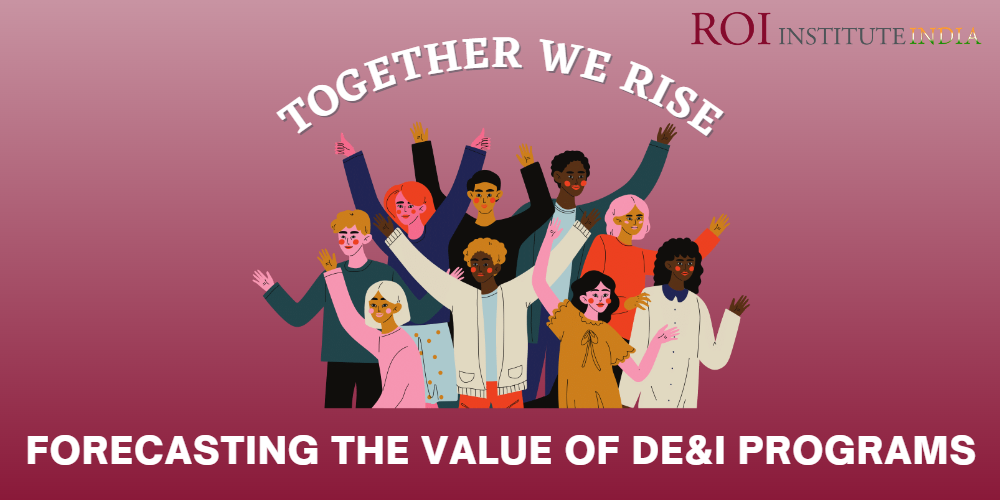Forecasting the Value of DE&I Programs
Diversity, equity, and inclusion (DE&I) initiatives are becoming necessary, in today's world, where companies are looking for ways to differentiate themselves. These initiatives can transform businesses by creating a truly inclusive workplace culture that drives employee satisfaction and retention. However, many companies struggle with their DE&I initiatives and face challenges that stall their efforts. Becoming familiar with these top challenges can provide clarity on why a strategy may be stalling, and how to allocate efforts differently to address those challenges.
- Low budget allocation: One of the most important aspects of DE&I is monitoring and executing it across the entire organization; rather than viewing it as a function of HR only. Although the concept of DE&I may seem new, it should have a prioritized place in every department. Companies often don't dedicate enough of their budget to DE&I and believe it is a one-person role, resulting in inexperienced staff. Tying their DE&I strategy to key business initiatives can help businesses overcome these challenges.
- Measuring success: Measuring DE&I success can also be challenging for businesses, as they often get bogged down in numbers due to the extensive amount of available stats. It's essential to assess both quantitative and qualitative data, such as the improvement in the rate and time of promotion of diverse hires, increases in the diversity mix of supervisory and leadership positions, reduction of discrimination grievances, and an increase in employee engagement and participation.
- Lack of consistency: DE&I initiatives and resources can be challenging to address, whether in-person or remote, but it is vital to stay consistent. Companies should regularly educate the organization on their biases and how they can actively participate in DE&I with strategic resources.
One possible solution to embedding DE&I into company culture long-term is to use the ROI Methodology®, a proven framework for evaluating a program or intervention's effectiveness and return on investment (ROI). Developed by Dr. Jack Phillips, the ROI Methodology has been applied to various fields such as learning and development, human resources, marketing, and social responsibility. It consists of five levels of evaluation:
- Level 1: Reaction and Planned Action - This level measures the participants' satisfaction with the program and their intention to apply what they learned.
- Level 2: Learning - This level measures the participants' acquisition of knowledge, skills, and attitudes from the program.
- Level 3: Application - This level measures how well the participants apply what they learned in their work.
- Level 4: Business Impact - This level measures the tangible business outcomes resulting from the program, such as increased revenue, reduced costs, improved customer satisfaction, or higher employee retention.
- Level 5: ROI - This level measures the financial return on the program investment, calculated as the net program benefits divided by the program costs.
The ROI Methodology, with its robust Evaluation Framework and 12-step Process Model, can help companies to forecast the value of their DE&I programs. Here are some ways in which the ROI Methodology can help:
- Aligning with Business Objectives: The ROI Methodology helps companies align their DE&I programs with their business objectives. It enables them to identify areas where DE&I can add value to the business, e.g. by improving innovation, employee engagement, and customer satisfaction. By aligning DE&I initiatives with business objectives, companies can ensure their efforts are targeted and strategic.
- Benchmarking: Use available benchmarking data to predict the outcomes at different levels defined in the ROI Methodology (i.e. Reaction, Learning, Application, and Impact Improvement). This enables companies to predict the possible outcome and performance based on available data and identify areas where they can improve. It also allows them to benchmark their DE&I programs against industry best practices. By benchmarking their DE&I initiatives, companies can ensure they are staying competitive and on track to achieve their goals.
- Quantifying the Impact: The ROI Methodology helps companies quantify the impact of their DE&I programs. It enables them to measure the effectiveness of their programs and identify areas where they can improve. By doing so, they can make informed decisions about how to allocate resources and prioritize initiatives.
- Forecasting ROI: The ROI Methodology enables companies to show the financial benefits of investing in DE&I, such as increased revenue, reduced turnover, and improved productivity. To make a compelling case for continued investment in these initiatives, it is essential that any improvement forecasted is annualized and the fully loaded costs considered in the estimate.
- Identify potential Intangible Benefits: The Guiding Principles of ROI Methodology require that every program should also report any Intangible Benefits. Intanagible benefits are those improvements which cannot be converted to monetary values. Communicating the Intangible Benefits will also help build confidence in the program.
In summary, the ROI Methodology can help companies forecast the value of their DE&I programs by quantifying the impact, aligning with business objectives, demonstrating ROI, and benchmarking against industry best practices. By doing so, companies can ensure that their DE&I initiatives are targeted, effective, and strategic.








